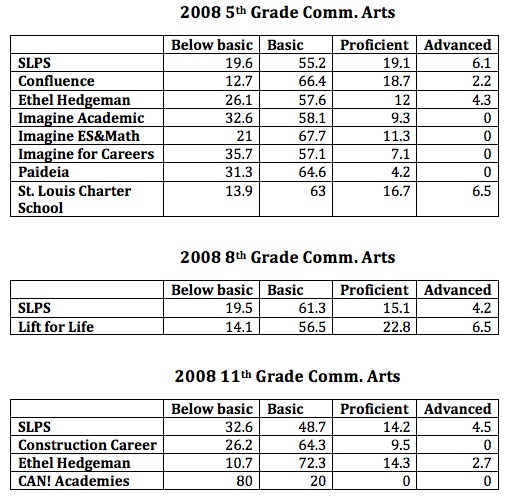Arne Duncan
Charter schools as partners?
03/21/09 12:41 Categories: Charter schools
Is St. Louis moving to a “portfolio” approach to public education, as Education Secretary Arne Duncan calls New Orleans where charter schools make up over half of the public schools? Duncan said the model works as long as accountability requires the quick closing of poor performing schools.
Kelvin Adams, the new SLPS superintendent, brings a willingness to work with charter schools. In a recent interview on St. Louis on the Air on KWMU, he explained his rationale.
It’s not about charters schools or not charter schools but about what’s best for our kids.
He talked about sharing ideas about what works between charter schools and regular public schools and how they influence each other.
State Sen. Jeff Smith has been twittering about attending committee and board meetings for Confluence Academy.
At achievement subcommittee mtg for Confluence Academy, charter skl susan uchitelle and I co-founded in 2000. doing well but need 2 do bettr
At Confluence Academies board mtg. They're the charter skls I co-founded in 2000. We're abt to move into a new bldg, the stl pub library...
I haven’t focused on the charter schools, but he got me to thinking about the quality of charter schools here in St. Louis. So I thought I would do a quick mini-check. I randomly chose fifth grade comm. arts MAP scores to compare and 11th grade for the high school charter schools. Since Lift for Life only has middle school scores, I included its eighth grade MAP scores.

I can definitely see some charter schools than need some attention. Confluence, St. Louis Charter School and Lift for Life seem to be doing the best but with a lot of room left to improve. The CAN! charter school for high school drop-outs has been closed.
With KIPP coming to St. Louis to provide some upward competition for the charters and an openness to charter schools from the new SLPS superintendent, a dynamic partnership that incubates new ideas and improves education for all may be coming to the Lou.
Longer school year?
03/11/09 16:17 Categories: Policy
Arne Duncan is looking at longer school days or years to help improve our country’s education and to help our students compete in a global economy in which many countries such as India and China go 20 to 30 days more a year. I’m sure students won’t like this idea, I doubt teachers will, and I’m not confident parents will either. However, I think that we should consider a longer school year.
I was at a committee meeting last night at my children’s elementary school in which the principal was telling us about a decision made to change the allocation of minutes. Every addition of time is a trade-off. Adding more minutes to the school day isn’t necessarily the best decision since young children need some time to play, but a longer year would ease the minute turf war and reduce summer retention problems.
The parents at the meeting kept asking about when the teachers were able to meet together district-wide by grade level. Teaching has traditionally been a solitary profession but is increasingly team-oriented as planning is done in groups. To facilitate this districts need to provide time for teachers to meet in various teams. Some districts do better at this than others, but all of them need to do more.
School year length ranges from 190 days for Farmington to 167 for Wheatland in Hickory County and Appleton City in St. Clair County. The St. Louis city and county districts have a narrower range from 174 to 178 with Ritenour as an outlier at 182 (good for it!). (Numbers from DESE)
The length of school day in St. Louis county and city ranged from 6.6 in Kirkwood (with quite a few districts at 6.5) to Jennings at 6.0. Jennings has a shorter day and one of the shorter years, but other districts mixed the two. For example, Clayton has one of the longer years but shorter days to allow for after school teacher meetings. Some of the districts such as University City and Bayless had a longer day at 6.5 hours but relatively shorter year at 175 days. Kirkwood, Ladue and Ritenour have students attending the most hours. Jennings and Hazelwood are at the bottom.
The number of hours taught ranged in the state from a high of 1209.5 (Centerville in Reynolds County) to 1014.5 (Calhoun in Henry County).
I predict that the we don’t have a significant change in the next couple of years but a quickening of the incremental pace we’ve been having in the increase of time as pressures mount on districts to improve. The state will need to come in and establish minimums for the rural areas that don’t face the same competition.